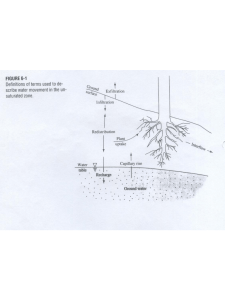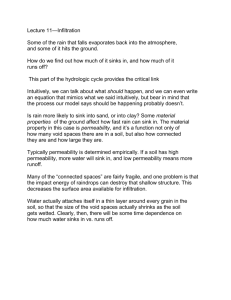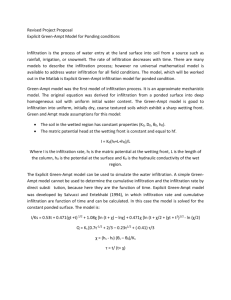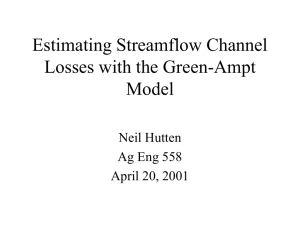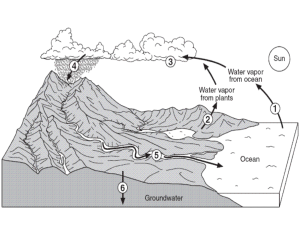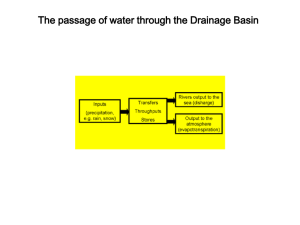GREEN-AMPT INFILTRATION MODEL
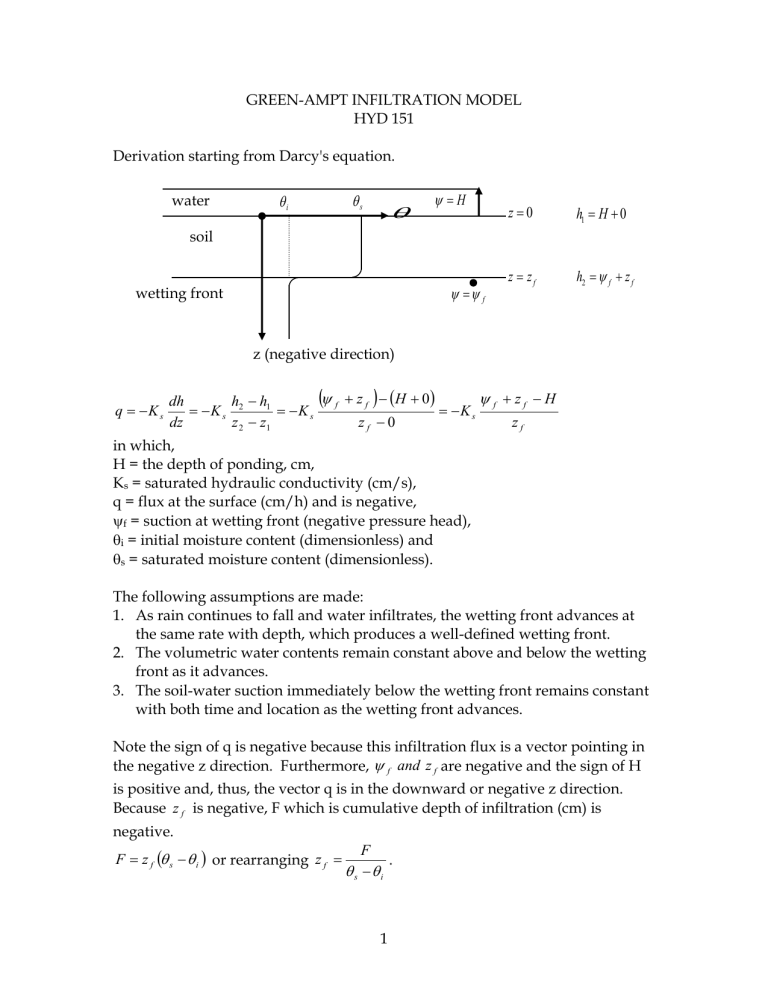
GREEN-AMPT INFILTRATION MODEL
HYD 151
Derivation starting from Darcy's equation. water soil
i
s q
wetting front
K s dh dz
K s h
2 z
2
z (negative direction) h
1 z
1
K s
f
z z f f
0
H
0
H
K
s f
f
z
0 z
z f z z f f
H h
1
H
0 h
2
f
z f in which,
H = the depth of ponding, cm,
K s
= saturated hydraulic conductivity (cm/s), q = flux at the surface (cm/h) and is negative,
f
= suction at wetting front (negative pressure head),
i
= initial moisture content (dimensionless) and
s
= saturated moisture content (dimensionless).
The following assumptions are made:
1.
As rain continues to fall and water infiltrates, the wetting front advances at the same rate with depth, which produces a well-defined wetting front.
2.
The volumetric water contents remain constant above and below the wetting front as it advances.
3.
The soil-water suction immediately below the wetting front remains constant with both time and location as the wetting front advances.
Note the sign of q is negative because this infiltration flux is a vector pointing in the negative z direction. Furthermore, f and z f are negative and the sign of H is positive and, thus, the vector q is in the downward or negative z direction.
Because z f
is negative, F which is cumulative depth of infiltration (cm) is negative.
F
z f
s
i
or rearranging z f
F
s
i
.
1
Flux at the surface is equal to the infiltration rate f which is also negative and has units of cm/hr. It is the first derivative of F with respect to time t in hr. q
f
dF dt
Substituting into Darcy's equation gives the following equation. q
f
dF dt
K
f
s s
F
F
i
H
K
f
s
F
i
H
s
F
i .
i
Assume H is small relative to the other terms and the previous equation simplifies to the Green and Ampt infiltration rate equation. f
dF dt
K
f
s
F
i
1
[1]
Rearranging the [1] gives the cumulative infiltration F as a function of infiltration rate f. f
K
1
f
s
F
i
F
f s
i
1
f
K
For F to be negative, f<-K.
How do we introduce time dependence in equation [1] which is a relation between f and F? Separate variables in equation [1].
f
s
1
i
F
1
dF
K s dt
f
s
F
i
F
dF
K s dt
Use u substitution to integrate. u
f
s
i
F
F
u
f
s
i
du
dF
Substitute the above into the differential equation.
u
s
u
i
f du
K s dt
Integrate the previous equation. u
s
i
f ln u
K s t
Substitute the original variables back into integrated equation.
2
s
i
f
K s t f
F f
F
s
s
i
i
f
f ln
ln
s s
s
i
i
i
f
f f
F f
F
F f
F f
0
K s t
s t f
0
i
f ln
1
s
Although t f
can be expressed explicitly as a function of
F f
as,
F f
i
f
[4] t f
F f
s
i
f ln
1
s
K s
is an implicit function of t f
F f
i
. f
, [5]
F f
Notice that the signs are different in the original form of Green-Ampt equations.
K s t
F
f
s
i
ln
1
s
F
i
f
[6] t
F
f
s
i
ln
1
s
F
i
f
f
K s
1
s
i
K
s f
[7]
F
With these changes, F, f, and f
are positive rather than negative as in equations
[4] and [1].
To plot these functions, substitute F into equations [6] and [7] and solve for time t and infiltration rate f. First plot F as a function of t and then combine the results of equations [6] and [7] to plot f as a function of t.
If rainfall intensity is constant and eventually exceeds infiltration rate, then at some moment the surface will become saturated and ponding when the infiltration rate equals the precipitation rate. The depth infiltrated at that moment (F s
) is given by setting f = i in equation [7] and solving for
F s
s
i
i K s
1
f
F s
:
[8] in which, i = rainfall rate (cm/s), (i must be greater than K s
)
F s
= total amount of water infiltrated (cm) and t s
= time of ponding.
Time of ponding is given by t s
= F s
/i [9]
3
Example:
For the following soil properties, determine the amount of water when ponding occurs, the time to ponding, plot the cumulative infiltration function, and plot infiltration rate (f) versus infiltration volume (F): Ks = 1.97 cm/hr, i
= 0.318, s
=
0.518, i = -7.88 cm/hr,
F
f
1 s
f
K i
(
9 .
f
37
= -9.37 cm. Using equation [1]
)
0 .
518
1
7
0
.
.
88
1 .
97
318
0 .
625
cm or using equation [4] and Ks = 1.97 cm/hr,
f
= 9.37 cm: i
= 0.318,
Fs = (.518-.318)·(9.37)/(7.88/(1.97)-1) = 0.625 cm s
= 0.518, i = 7.88 cm/hr,
From equation [6]: t s
= (0.625/7.88) = 0.079 hrs = 4.74 minutes = 284 seconds.
Until 0.625 cm has infiltrated, the rate of infiltration is equal to the rainfall rate.
Thereafter substitute F into equations [6] and [7] and solve for time t and infiltration rate f. First plot F as a function of t and then combine the results of equations [6] and [7] to plot f as a function of t.
4


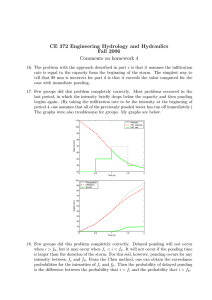
![CEE 6510 – Fall 2004 – Assignment No. 4 [1].](http://s2.studylib.net/store/data/010473112_1-af600076b3994900d26855dfb0f9104d-300x300.png)
